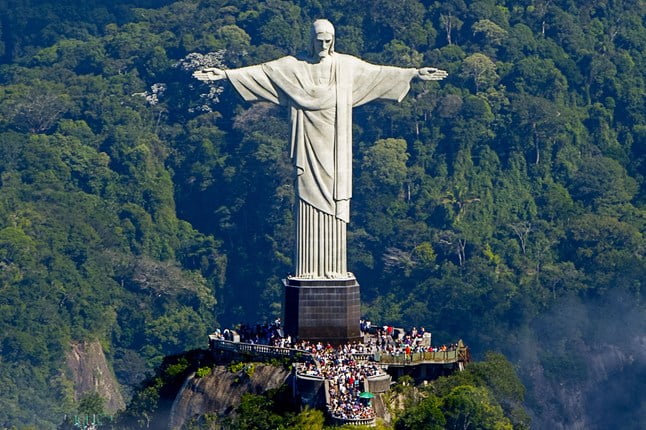Christ the Redeemer is one of the New Seven Wonders of the World, and a symbol of Christianity across the world. The statue was built by Heitor da Silva Costa, a Brazilian engineer. French engineer Albert Caquot and Romanian sculptor Gheorghe Leonida also worked on the statue. Christ the Redeemer is 98ft tall, and that is without the 26ft pedestal. The arms of Christ stretch for 92ft wide. The statue weighs 635 metric tons. Located at the peak of 2,300ft Corcovado Mountain, Christ overlooks the city of Rio. Here are some interesting facts about the statue.
– The statue was built as a response to fear. Once Brazil got its independence in 1889, the church and the state were separated. Fear began among Catholics that the nation was headed towards a precipice. During World War I, followers in Brazil felt they need some symbol, and in 1920 the design of the statue was approved
– The original design featured Christ carrying a large cross in one hand, and a globe in the other. The initial design by Heitor da Silva Costa was approved, but it quickly gained a playful name “Christ with a ball”. Because of that, the engineer surveyed the area, consulted some artists, and came up with a new design, which is the arms-wide-open Christ
– Da Silva Costa needed world-class partners, so he traveled to Europe to find his partners. He found one in France. It took nine years for the team to build the sculpture. At the beginning, the team fashioned the sculpture in clay pieces. After that, the pieces were shipped to Brazil and remade with reinforced concrete
– Speaking of the design of the statue, it is covered with 6 million stone tiles. The reason is simple, the concrete was too rough for the fine contours of Christ. Heitor found inspiration in a fountain in Paris, and decided to use tiles to cover Christ
– The tiles used for Christ are littered with hidden messages. BBC ran a story that workers who made the tiles wrote on the back. Most of them wrote their name, but some wrote messages and prayers as well
– In 2006, a small chapel was built at the base of the sculpture. Authorities decided to build the chapel to celebrate the 75th anniversary of the statue. However, bear in mind that the chapel has limited space inside
– Another renovation was made in 2003, when authorities decided to make the trip easier. Before that, visitors had to scale more than 200 steps to get from the train to the statue. Authorities installed escalators and elevators in 2003. This made the journey easier
– In 2010, acrobatic graffiti artists scaled the statue and wrote all over the head, arms, and chest. The vandals turned themselves in, and the city’s mayor called the act “a crime against the nation”
– A statue of Christ was proposed in the 1850s by a local priest. Pedro Maria Boss presented his idea for a statue in front of the finance department. The department found the statue less feasible, and rejected the idea
– Christ the Redeemer is extremely tall, but it is just the third tallest statue of Jesus. Christ the King in Poland and Cristo de la Concordia in Bolivia are taller statues
– It was expensive to build the statute. According to estimates, it cost $250,000 to build Christ the Redeemer. That is equal to $3.2 million today. The Catholic community of Brazil donated all the money needed for the building process
– Thunder has damaged the statue more than once. The first time was in 2008, when the thunder strike damaged the head, eyebrows, and fingers of the statute. The statue was reconstructed using the same stone. Another lighting strike damaged the finger of the statue in 2014
– In May 2014, Lee Thompson took a selfie from the top of the head. The travel blogger got permission from authorities before taking the valiant task of climbing to the top and taking a selfie.



